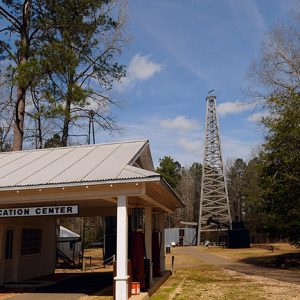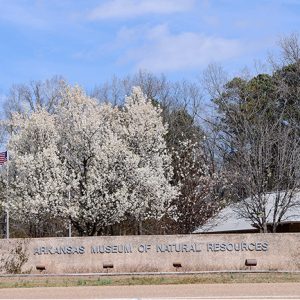calsfoundation@cals.org
Arkansas Museum of Natural Resources
| Location: | Union County |
| Area: | 19 acres |
The Arkansas Museum of Natural Resources houses exhibits that tell the story of oil and bromine production in southern Arkansas, with particular attention given to the historic oil boom that began in the 1920s. The center also interprets the history of these resources from the beginning of the oil’s creation eons ago through modern times.
In the 1920s, nationwide attention focused on this area when the Smackover oil field was ranked first among the nation’s oil fields with a yearly production of sixty-nine million barrels in 1925. In 1925, during south Arkansas’s oil boom, the forty-square-mile Smackover oil field was the focal point of one of the fastest mineral booms in North America, with 1,000 wells drilled in the first six months at a success rate of ninety-two percent. The town of Smackover (Union County) grew from a population of 100 to 25,000. However, due to a lack of conservation laws, the natural gas that provided the pressure necessary to remove the petroleum escaped; by the early 1930s, the oil boom was over, and the saltwater that rose with the oil polluted the landscape. The south Arkansas oil fields expanded throughout a ten-county area and are still producing petroleum, but at a much slower rate than before.
In 1975, a small group of individuals envisioned a museum that would preserve and interpret Arkansas’s oil history. Two years later, the Arkansas General Assembly passed Act 310, which levied a tax on the state’s oil production to fund the museum’s construction and operation. In 1979, the legislature also levied a tax on brine, or saltwater, which is often found alongside oil deposits and from which bromine is extracted. Bromine, a smelly, reddish brown, poisonous liquid, is used in making medicines, flame retardants, pesticides, and a variety of other chemicals.
In 1980, Jack Turner and his wife of El Dorado (Union County) donated nineteen acres in Smackover as a site for the Arkansas Oil and Brine Museum. The facility operated under that name from its completion in May 1986 until being renamed the Arkansas Museum of Natural Resources in 1997.
The museum’s 25,000-square-foot exhibition center includes vintage photographs; an auditorium that features two videos; a “Center of the Earth” exhibit that visitors enter through a circular corridor depicting rock strata in the earth; a geologic time scale and fossil exhibit explaining how oil is formed; metal-cast and life-size “roughnecks” working an oil derrick; exhibits on family life in the oil fields; dozens of vintage automobile gasoline pumps and petroleum company signs; exhibits on life in the area before the boom; and exhibits on modern drilling techniques.
A high-tech elevator takes visitors through time from a Jurassic period sea floor to the Industrial Revolution. An adjoining exhibit focuses on the evolution of oil consumption from 1922 through modern times. From this exhibit, visitors can peer from a replica of the Rogerson Hotel’s second-floor veranda overlooking a re-created, boom-era street scene in Smackover. The scene, which can also be explored on the first floor, includes numerous storefronts, a jail, a newspaper office, mannequins in period dress, and vintage automobiles.
Outside, the center’s Oilfield Park features operating examples of the oil-producing technology employed from the 1920s through today. The park contains a 112-foot wooden derrick similar to the one at the original Busey No. 1 Well in El Dorado. For those wanting to see an active oil field, the museum’s staff has prepared maps for either six- or fifteen-mile driving tours of the Smackover field that reveal remnants of early production, such as salt flats. The field is located just north of the museum.
For additional information:
Arkansas State Parks–Museum of Natural Resources. http://www.arkansasstateparks.com/museumofnaturalresources/default.aspx (accessed September 21, 2022).
Ellis, Randy. “Museum to Trace Oil Boom.” Arkansas Gazette. December 6, 1981, p. 1F.
Staff of the Arkansas Department of Parks and Tourism
Staff of the CALS Encyclopedia of Arkansas
 Environment
Environment Meyer, Rhena Salome Miller
Meyer, Rhena Salome Miller State Parks Division
State Parks Division Arkansas Museum of Natural Resources
Arkansas Museum of Natural Resources  Arkansas Museum of Natural Resources
Arkansas Museum of Natural Resources 




Comments
No comments on this entry yet.